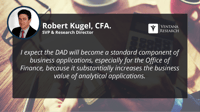Unit4’s Financial Planning and Analysis (formerly Prevero) is a planning and budgeting application designed for the requirements of midsize corporations and the public sector. These organizations are challenged in buying software because they have almost all the requirements of larger enterprises but have a smaller budget and limited technical resources.
Read More
Topics:
Office of Finance,
embedded analytics,
Analytics,
Business Intelligence,
Business Planning,
Financial Performance Management,
Price and Revenue Management,
Digital Technology,
ERP and Continuous Accounting,
collaborative computing,
AI and Machine Learning
IBM Planning Analytics, formerly known as TM1, is a comprehensive planning and analytics application designed to integrate and streamline an organization’s planning processes. It can support multiple planning use cases on a single platform, including financial, headcount, sales and demand planning. The software automates enterprise-wide data collection to make it repeatable and scalable across multiple users and departments. It supports sophisticated driver-based modeling that enables rapid...
Read More
Topics:
Office of Finance,
embedded analytics,
Analytics,
Business Intelligence,
Collaboration,
Business Planning,
ERP and Continuous Accounting,
Predictive Planning,
AI and Machine Learning
Ventana Research recently announced its 2021 market agenda for the Office of Finance, continuing the guidance we’ve offered since 2003 on the practical use of technology for the finance and accounting department. Our insights and best practices aim to enable organizations to operate with agility and resiliency, improving performance and delivering greater value as a strategic partner.
Read More
Topics:
Office of Finance,
enterprise profitability management,
Business Intelligence,
Collaboration,
Business Planning,
Financial Performance Management,
ERP and Continuous Accounting,
Revenue,
blockchain,
robotic finance,
Predictive Planning,
virtual audit,
AI and Machine Learning,
virtual close,
lease and tax accounting
BlackLine recently held its first virtual user conference, Beyond the Black, where it detailed numerous additions and enhancements to its applications. Of note was the launch of BlackLine Cash Application, an accounts receivable (AR) processing software based on software originally developed by recently acquired Rimilia. The new application fits the company's product strategy of providing accounting departments with software that automates time-consuming repetitive tasks and substantially...
Read More
Topics:
Office of Finance,
Business Planning,
Financial Performance Management,
ERP and Continuous Accounting,
AI and Machine Learning
In the context of planning, budgeting and benchmarking, external data includes information about the world outside an organization such as economic and market statistics, competitors and customers. Today, a comprehensive set of external data is a “nice to have” item in most organizations, but that’s likely to change. External data is necessary for useful and accurate business-focused planning and budgeting, and for performance benchmarking. It is also essential for the effective applications of...
Read More
Topics:
Information Management,
Business Planning,
Financial Performance Management,
Predictive Planning,
AI and Machine Learning
Can you imagine a more arcane and boring topic than accounts receivable? Unless you are the CFO, controller, chief accounting officer or treasurer of an organization, maybe not. Anecdotally, as it’s part of the trend to the digital transformation of all things in the department, there appears to be greater interest in this area of the Office of Finance. With populations locked down and the accounting staff unable to work in an office, the need to operate virtually has accelerated the...
Read More
Topics:
Office of Finance,
Financial Performance Management,
ERP and Continuous Accounting,
robotic finance,
AI and Machine Learning
Enterprise resource planning (ERP) systems are central to nearly every organization’s management of operational and financial business processes. They are essential to the smooth functioning of an organization’s record keeping, accounting and finance tasks. In manufacturing and distribution, ERP manages inventory and logistics. Some ERP software vendors incorporate an extended set of capabilities that include managing human resources as well as supply chains and logistics. In the 2020s,...
Read More
Topics:
Office of Finance,
Financial Performance Management,
ERP and Continuous Accounting,
robotic finance,
Predictive Planning,
AI and Machine Learning
An important recent development in software designed for the Office of Finance is the addition of what we’re calling a data aggregation device (DAD) for analytical applications. A DAD automates the collection of data from disparate sources using, for example, application programming interfaces (APIs) and robotic process automation (RPA). With a DAD, users of the analytical application have immediate access to a much broader data set; one that incorporates operational as well as financial data...
Read More
Topics:
Office of Finance,
Analytics,
Business Intelligence,
Data,
Financial Performance Management,
Price and Revenue Management,
robotic finance,
Predictive Planning,
AI and Machine Learning
One of the challenges of being a practically minded technology analyst is squaring the importance of “the next big thing” with the reality of what most organizations are doing. For decades it’s been the case that “the next big thing” in the world of information technology is easily several years ahead of where most organizations are in their use of technology. And before most organizations can realize the benefit of some whiz-bang technology, they frequently need to address a range of more...
Read More
Topics:
Human Capital Management,
Marketing,
Office of Finance,
Analytics,
Business Intelligence,
Sales Performance Management,
Financial Performance Management,
Price and Revenue Management,
Digital Marketing,
Work and Resource Management,
Digital Commerce,
Operations & Supply Chain,
Enterprise Resource Planning,
ERP and Continuous Accounting,
robotic finance,
Predictive Planning,
revenue and lease accounting,
Subscription Management,
intelligent sales,
AI and Machine Learning
Kinaxis recently held its annual user conference, Kinexions, which focuses on helping the company’s customers improve their execution of supply chain and sales and operations planning (S&OP). Its RapidResponse software handles S&OP, demand, supply, inventory and capacity planning. S&OP is a function sorely in need of improvement: Our research finds that only 22 percent of companies perform it well or very well.
Read More
Topics:
Continuous Planning,
Analytics,
Enterprise Resource Planning,
continuous supply chain,
AI and Machine Learning




















